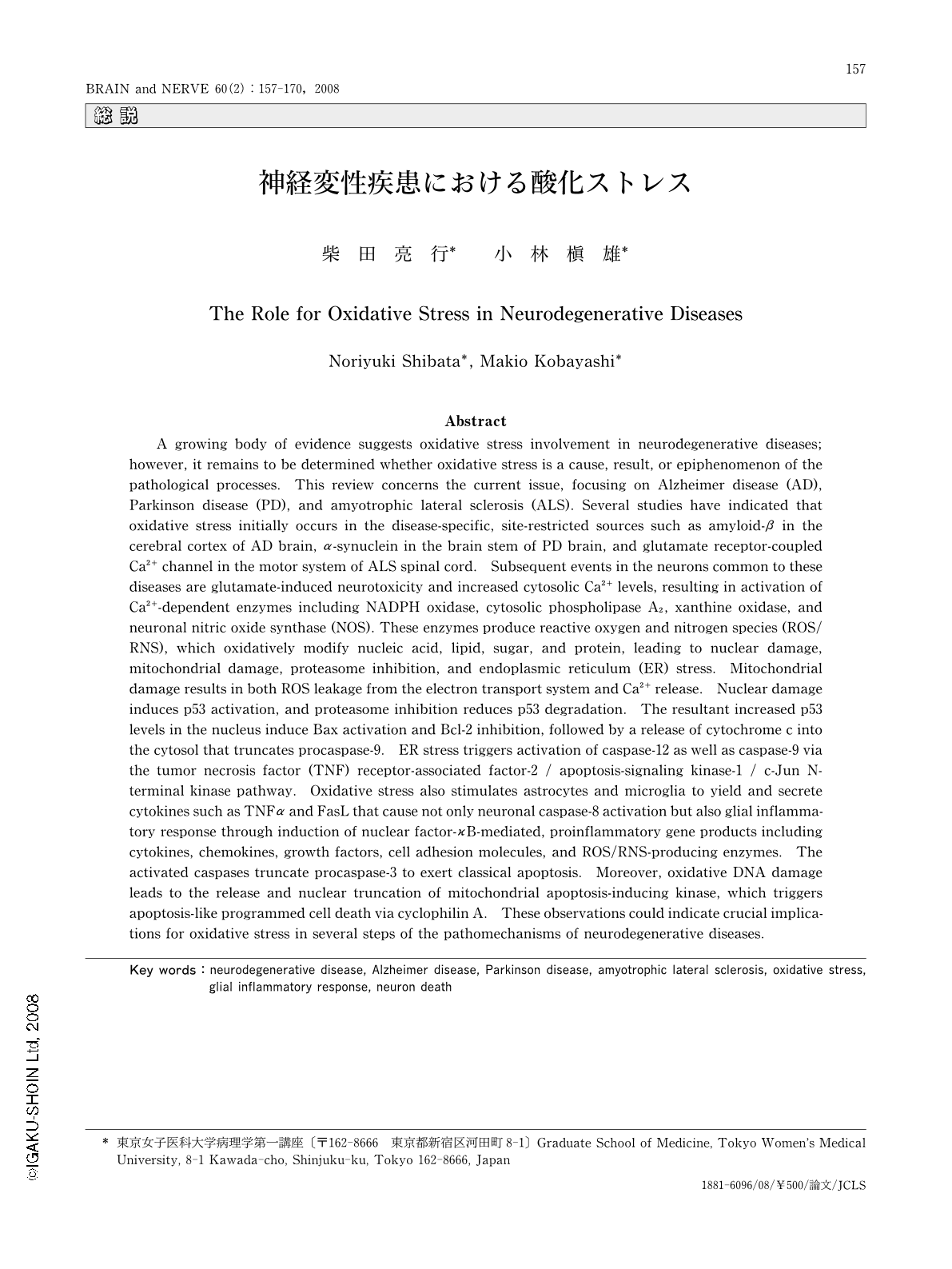Japanese
English
- 有料閲覧
- Abstract 文献概要
- 1ページ目 Look Inside
- 参考文献 Reference
はじめに
アルツハイマー病(AD),パーキンソン病(PD),筋萎縮性側索硬化症(ALS),進行性核上性麻痺,ピック病,皮質基底核変性症,多系統萎縮症,ハンチントン病(HD)などに代表される神経変性疾患は,疾患概念が確立されて以来,長きにわたって原因不明とされてきた。しかし,分子生物学的手法の発展と普及に伴い,近年その病態が明らかにされつつあり,酸化ストレスの関与を示唆する報告はとりわけ多い1-7)。確かに,ADにおけるアミロイド-β(Aβ)の蓄積,PDにおけるα-シヌクレイン(αS)の蓄積あるいはALSにおけるグルタミン酸受容体サブユニットGluR2のRNA編集率低下が,酸化ストレスの発生に関連するとの指摘は興味深い3,4,6,8-10)(Fig.1)。ただし,酸化ストレスが神経変性疾患の原因,結果,随伴現象のいずれなのかについては議論のあるところである11-13)。酸化ストレスとは,生体内に生じた活性酸素種(ROS)や活性窒素種(RNS),およびこれらから派生する酸化修飾産物が生命現象に与える影響を表現する専門用語である14-16)。酸化ストレスがもたらす結果は,ROS/RNSの種類と多寡あるいは細胞種により多岐にわたる。生理的な状況では軽微な酸化ストレスが正常な細胞活動を支えるのに対し,病的な状況では強力な酸化ストレスが細胞死,炎症反応,細胞増殖などを惹起する。神経変性疾患は慢性的な経過をたどるので,組織や細胞が短時間で機能停止に陥る急性疾患とは質的量的に異なる酸化ストレスが病態に関わると予想される。本稿では,この点に配慮しつつ,AD,PDおよびALSを中心に,病態に関与する酸化ストレスについて概説する。
Abstract
A growing body of evidence suggests oxidative stress involvement in neurodegenerative diseases; however, it remains to be determined whether oxidative stress is a cause, result, or epiphenomenon of the pathological processes. This review concerns the current issue, focusing on Alzheimer disease (AD), Parkinson disease (PD), and amyotrophic lateral sclerosis (ALS). Several studies have indicated that oxidative stress initially occurs in the disease-specific, site-restricted sources such as amyloid-β in the cerebral cortex of AD brain, α-synuclein in the brain stem of PD brain, and glutamate receptor-coupled Ca2+ channel in the motor system of ALS spinal cord. Subsequent events in the neurons common to these diseases are glutamate-induced neurotoxicity and increased cytosolic Ca2+ levels, resulting in activation of Ca2+-dependent enzymes including NADPH oxidase, cytosolic phospholipase A2, xanthine oxidase, and neuronal nitric oxide synthase (NOS). These enzymes produce reactive oxygen and nitrogen species (ROS/RNS), which oxidatively modify nucleic acid, lipid, sugar, and protein, leading to nuclear damage, mitochondrial damage, proteasome inhibition, and endoplasmic reticulum (ER) stress. Mitochondrial damage results in both ROS leakage from the electron transport system and Ca2+ release. Nuclear damage induces p53 activation, and proteasome inhibition reduces p53 degradation. The resultant increased p53 levels in the nucleus induce Bax activation and Bcl-2 inhibition, followed by a release of cytochrome c into the cytosol that truncates procaspase-9. ER stress triggers activation of caspase-12 as well as caspase-9 via the tumor necrosis factor (TNF) receptor-associated factor-2 / apoptosis-signaling kinase-1 / c-Jun N-terminal kinase pathway. Oxidative stress also stimulates astrocytes and microglia to yield and secrete cytokines such as TNFα and FasL that cause not only neuronal caspase-8 activation but also glial inflammatory response through induction of nuclear factor-κB-mediated, proinflammatory gene products including cytokines, chemokines, growth factors, cell adhesion molecules, and ROS/RNS-producing enzymes. The activated caspases truncate procaspase-3 to exert classical apoptosis. Moreover, oxidative DNA damage leads to the release and nuclear truncation of mitochondrial apoptosis-inducing kinase, which triggers apoptosis-like programmed cell death via cyclophilin A. These observations could indicate crucial implications for oxidative stress in several steps of the pathomechanisms of neurodegenerative diseases.

Copyright © 2008, Igaku-Shoin Ltd. All rights reserved.


